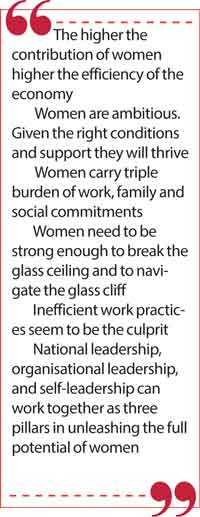Saturday Apr 05, 2025
Saturday Apr 05, 2025
Friday, 6 March 2020 00:00 - - {{hitsCtrl.values.hits}}

Half of the world’s population is represented by women. As calculated by the World Bank women represent 49.5% of the world population in 2018. Despite this number we have failed to unleash the full potential and contribution of women in the world of work and thereby in creating economic value. 
As estimated by the World Bank only one in three women participate in the labour force in Sri Lanka and this situation is even more critical as female labour force participation has declined from 41% in 2010 to 36% in 2016 despite the expansions in the local economy.
Keeping women away from the world of work is such a waste! This is a good indication of economic inefficiency. The more we keep women away from work, the more inefficient the economy will be. Therefore it is the responsibility of both the organisational and national leadership to attend to this situation and to unleash the potential of an untapped and underutilised resource in achieving great economic value. This will also have a ripple effect on other areas of social, cultural, political and a positive contribution towards the Sustainable Development Goals (SDGS).
Two major hindrances for women in the world of work
There are two major hindrances for women in the world of work, the first being the ‘glass ceiling’ and the second being the gender pay gap. These are part of the global gender gap among many other aspects as described by the World Economic Forum.
The ‘glass ceiling’ is a metaphor used to describe a phenomenon that inhibits women from advancing in their careers due to invisible barriers. This is quite evident in our society where despite many women participation in managerial and professional levels they have failed to reach out to the c-suite or top management positions.
The problem here is twofold. i.e. the percentage of women at senior or top management positions are small or minor and that the growth of women progressing towards these higher levels are also slow despite continued efforts.
Many studies have taken place to analyse this phenomenon and the causes. As per an article published in Harvard Business Review by Robin J. Ely and Irene Padavic (March-April 2020), this situation is not resultant due to lack of ambition among women. Equally as men, women are also “ambitious”. So what really causes the situation?
Some perceive women to have limited ability to claim the helm. Their lack of experience in P&L management; especially with the limited experience into the sales and operational functions, absence of informal networking where women with their triple burden of work (i.e. work commitments, family commitments and social commitments) and cultural constraints have limited access or space for networking, the inability to balance work and life priorities, complacency, lack of role models; specially in local contexts with the lack of women reaching heights there will be a vacuum for role models to benchmark or to follow, stereotyping with many labels, myths about their abilities and responsibilities and issues related to sexual harassment have mainly contributed towards these claims of limited ability. These remain a question mark as these are regarded as not entirely valid reasons or causes for the issue. 
However, if the above outlined are factors that hinder and curtail the ability of the women to contribute to their fullest potential, then such matters need to be addressed. Finding solutions to them would be the responsibility of the organisational leadership and they should be held accountable through the performance appraisal systems.
Introduction of a proper mentoring system within an outside organisation, up-skill and development training, fostering role models, enhancing the organisational culture and infrastructure are some of the work that can be adopted at the organisational level to enhance the ability of women to advance.
Though on a common platform the above are considered as the most mutually-agreed reasons for the glass ceiling, a recently-conducted research published in Harvard Business Review by Robin J. Ely and Irene Padavic claims otherwise. They have found that long work hours are the culprit. This has resulted in overpromising and over delivering situations in the world of work. This is not unique only to women but equally fair on both men and women. However women seem to be paying the higher price due to family requirements that surface as priorities.
Organisations attempt to cover such inefficient work practices by pointing fingers at women’s inability to reach the top and to break the glass ceiling. Also the firms are quick to offer work-family accommodations as solutions in the form of part time work, taking leave from work, reduced work hours, etc. Women with their family priorities tend to opt for these options which in the longer run hinder their ability to advance in the careers. This situation not only curtails their career but also causes gender pay gap where women get paid less than their male counterparts.
Further one can also observe many myths around the gender pay gap that cloak the inefficiencies at work. Such myths include women having less experience and exposure for top jobs, women have no desire or will for top jobs, inability to perform aggressive negotiations due to emotions, women perceiving themselves as a ‘nurturer’ and how women regard themselves with low esteem and ability. These myths derail the focus from the main problem. Thus ancillary issues or factors are considered in-depth as main focus points. Therefore the problem remains the same and the effects aggravated specially for a developing economy like Sri Lanka.
If inefficient work practices such as long hours are keeping women away from the world of work and away from reaching the top, such practices need to be relooked at as it hinders macro level productivity negating the economic growth and value creation.
No matter how much the companies claim ‘equal opportunities’ and ‘non-discrimination,’ if organisational norms and biases prevail and lip service is given to analysing and not addressing the real causes of glass ceiling, effective changes to rectify the situation will not take place.
Also one of the main success factors of the organisational work towards this phenomenon is determined by how the top management or the organisational leadership treats, regards and perceives women at work. Despite many organisations, both local and global, assisting women break the glass ceiling fails to protect them with the glass cliff where women on the top fall off and fail. This challenges the sustainability, endurance and effectiveness of the organisational practices.
Thus not only helping to break the glass ceiling but also to navigate the glass cliff is vital to make world of work favourable, supportive and worthy for women.
Another major factor to consider as a factor is ‘child care’. This is a problem area for many women in the world of work. Also a major contributor for the glass ceiling and gender pay gap. Thus this is an area which requires national level support and strategy.
Research suggest that higher the maternity leave for women there is a better chance of retaining women in the work place and to assist them advance in their careers. Also this will have a positive contribution towards the pay gap. Especially with the emergence of the population ageing and the concept of grand parenting and extended families could provide a good solution coupled with structured child care systems and opportunities.
This is also an opportunity area for entrepreneurs and especially for women entrepreneurs to pursue as a social enterprise. Further the organisational contributions such as work place crèches, support systems and infrastructure development can contribute positively towards the problem solution. These are areas to be further explored and researched.
The three pillars can work together
Therefore as a concluding point we see that three pillars can work together to solve or to have a positive impact on the advancement of women in the world of work.
The first is organisational leadership and work practices. Impossibly long working hours will not yield productivity as revealed by many research findings but they will hinder the progress. Thus organisational leadership should discourage such practices and streamline its work practices to make the working environments more favourable towards women. This will make it good for men too! Thus the introduction of shorter work weeks, flex hours, working from home practices can be implemented not as work life accommodation practices but as organisational wide practices with no discrimination.
The second is childcare support. Under this a Government policy and initiatives to assist women either by improving systems, structures and infrastructure will be required. However an ad hoc approach to the issue will not be adequate. A holistic, integrated and a strategic approach will need to be explored by the Government.
For example, aspects such as ageing population, extended family concept, business models, entrepreneurship opportunities, education system and economic development need to be considered together to generate an integrated solution where the Government should take macro level leadership towards solving this issue.
The third pillar is self-leadership where women should be encouraged to change the negative ways they regard themselves. Especially when it comes to glass ceiling women are held back by many ‘labels’ such as ‘bad mothers,’ ‘selfish mothers,’ ‘show-off,’ ‘vanity,’ ‘bossy,’ to mention a few. Women seem to be surrounded by these labels and they require enormous strength to break them. Thus we need to create awareness among women about the status quo and give them leadership skills to break through the barriers and to create opportunities for them. Thus women focused training, awareness and support programmes will assist. This personal empowerment aspect will give women the wings to take off and to fly high may it be as an entrepreneur, intrapreneur or as corporate leaders.
We need to inform women and reaffirm that they are strong enough to break any barriers, any glass ceiling and to reach out to the top and to be the very best and that they are smart and intelligent enough with the acquired and natural instinct to avoid any traps and glass cliffs and to align men as allies to work side by side with them to drive our societies forward where the sustainable development goals become a reality.
#Break all barriers. #Break all labels. #wifit
(The writer is Founder and Chair, Women’s International Foundation – www.wifoundation.org.)